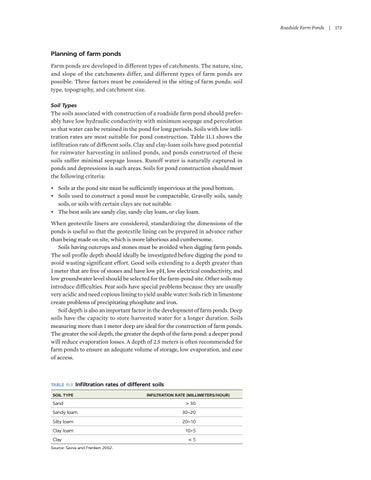Roadside Farm Ponds | 173
Planning of farm ponds Farm ponds are developed in different types of catchments. The nature, size, and slope of the catchments differ, and different types of farm ponds are possible. Three factors must be considered in the siting of farm ponds: soil type, topography, and catchment size. Soil Types
The soils associated with construction of a roadside farm pond should preferably have low hydraulic conductivity with minimum seepage and percolation so that water can be retained in the pond for long periods. Soils with low infiltration rates are most suitable for pond construction. Table 11.1 shows the infiltration rate of different soils. Clay and clay-loam soils have good potential for rainwater harvesting in unlined ponds, and ponds constructed of these soils suffer minimal seepage losses. Runoff water is naturally captured in ponds and depressions in such areas. Soils for pond construction should meet the following criteria: • Soils at the pond site must be sufficiently impervious at the pond bottom. • Soils used to construct a pond must be compactable. Gravelly soils, sandy soils, or soils with certain clays are not suitable. • The best soils are sandy clay, sandy clay loam, or clay loam. When geotextile liners are considered, standardizing the dimensions of the ponds is useful so that the geotextile lining can be prepared in advance rather than being made on site, which is more laborious and cumbersome. Soils having outcrops and stones must be avoided when digging farm ponds. The soil profile depth should ideally be investigated before digging the pond to avoid wasting significant effort. Good soils extending to a depth greater than 1 meter that are free of stones and have low pH, low electrical conductivity, and low groundwater level should be selected for the farm-pond site. Other soils may introduce difficulties. Peat soils have special problems because they are usually very acidic and need copious liming to yield usable water. Soils rich in limestone create problems of precipitating phosphate and iron. Soil depth is also an important factor in the development of farm ponds. Deep soils have the capacity to store harvested water for a longer duration. Soils measuring more than 1 meter deep are ideal for the construction of farm ponds. The greater the soil depth, the greater the depth of the farm pond: a deeper pond will reduce evaporation losses. A depth of 2.5 meters is often recommended for farm ponds to ensure an adequate volume of storage, low evaporation, and ease of access.
TABLE 11.1 Infiltration
rates of different soils
SOIL TYPE
Sand
INFILTRATION RATE (MILLIMETERS/HOUR)
> 30
Sandy loam
30–20
Silty loam
20–10
Clay loam
10–5
Clay Source: Savva and Frenken 2002.
<5







































